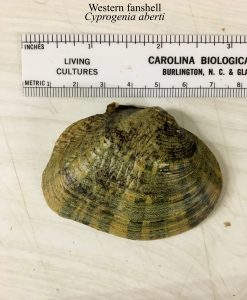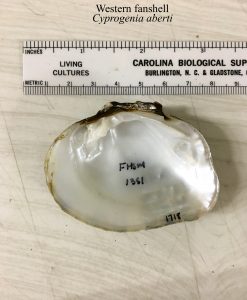Invertebrates (non-Insect)
Sternberg Museum of Natural History Invertebrate Zoology Collection (FHSM-I)

The Invertebrate Zoology Collection at FHSM contains a variety of invertebrates, excluding insects Entomology, and arachnids. The vast majority of the 2,854 specimens currently housed at FHSM are freshwater mussel shells and crustaceans, making it the largest collection of its kind in the region. The collection was started in 1984 by Dr. Thomas Wenke, aquatic ecologist and ichthyologist for FHSU at the time. In subsequent years, the collection was greatly enhanced by Dr. William J. Stark and Mark Eberle, along with their students. In 2015, the Kansas Biological Survey (Lawrence, KS) donated its freshwater mussel collection to FHSM, essentially doubling the size of the collection. The vast majority of the specimens housed at FHSM are from Kansas, with ancillary collections from Oklahoma, Missouri, Texas, and Tennessee.
The collection consists of a number of important voucher specimens from past surveys. Historically, freshwater mussels were found in large numbers throughout the United States, one of the most ecologically diverse countries in the world for freshwater mussels. These mussels serve as bioindicators, being some of the first organisms to disappear in response to environmental changes. Because of this, together with massive over-harvest in the early 1900s for the button industry, many species are now considered Threatened, Endangered, Locally Extirpated, or Extinct. Monitoring the changes in the health of freshwater mussel communities has become vital in understanding the negative effects of human activities, making historical collections such as those housed at FHSM invaluable.

There currently are no preserved tissue samples in the FHSM collection. Efforts are currently underway to create a searchable database of the collection.
Data Access
The collection can be accessed using the following links
Terms of Use
The Division of Invertebrate Zoology specimens, databases, and images are owned and copyrighted by the Sternberg Museum of Natural History or licensed to it. The data and images may be used freely by individuals and organizations for purposes of basic research, education, and conservation. These data and images may not be used for commercial or for-profit purposes without the express written consent of the Sternberg Museum of Natural History, and may not be repackaged, resold, or redistributed in any form. Use of the data or images in publications, dissertations, and theses, or other scientific reports, should be accompanied by an acknowledgment of the Division of Invertebrate Zoology, Sternberg Museum of Natural History, as the source for the information. Please provide the Department with separate articles resulting from the use of these data or images. This helps us to document the use of specimens as “vouchers” in the literature. It also helps us to justify continued funding for the collections so that these resources remain available in the future.
Outreach
The FHSM Staff is available for outreach programs at various levels (Grade School through High School, and adult organizations). Email Naturalist and Education Manager, Alicia Gaede, at algaede@fhsu.edu for more information.
Visiting
Visiting the collections is encouraged, when possible, especially when dealing with type and/or rare specimens. Please contact the appropriate Curator and Collections Manager for more information.
Please direct all specimen inquiries to:
Dr. Jackson R. Roberts, Zoological Collections Manager (jrroberts6@fhsu.edu)
Dr. William J. "Bill" Stark, Associate Curator (wstark@fhsu.edu)